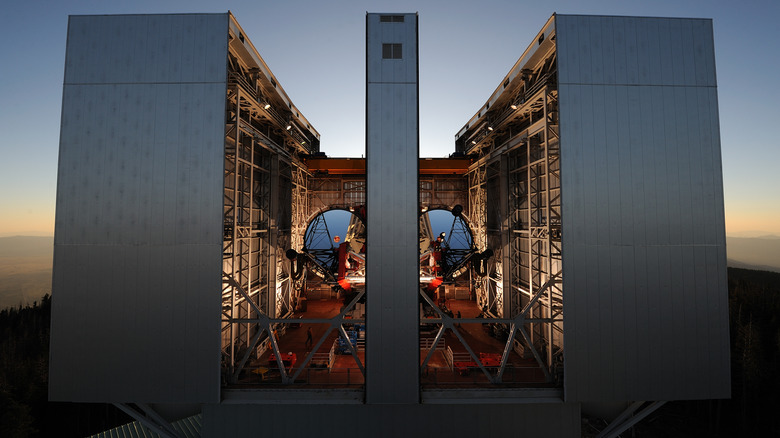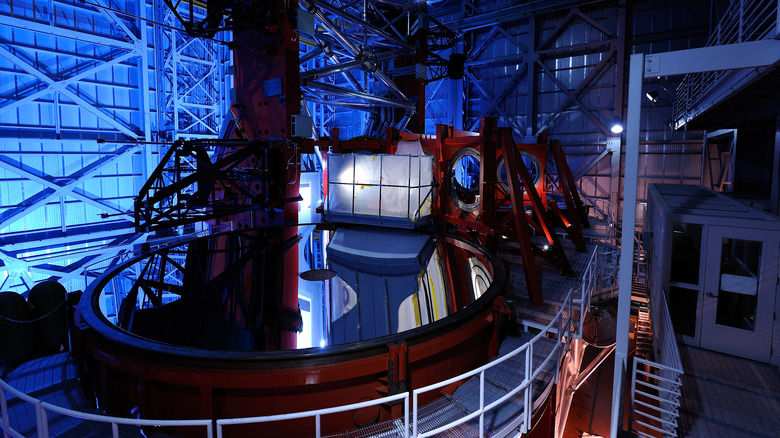One Of The World's Most Powerful Telescopes Hides In This Arizona Observatory Open For Public Use
High up in the Pinaleño Mountains, the stars of the vast Milky Way come trickling in through the lens of a solitary telescope fortress as researchers seek answers to that gnawing question: What else is out there? While travelers often associate Arizona with the stunning features of its land — like the Chiricahua National Monument, with its strange rocks and scenic hikes — the Mount Graham International Observatory in southern Arizona draws your attention toward the heavens. At this mountaintop observatory, a cluster of cutting-edge telescopes scan the final frontier, probing the deaths of stars or the moons of Jupiter. You can see how they work for yourself with a tour.
The Mount Graham International Observatory holds three powerful telescopes, including the famed Large Binocular Telescope Interferometer, the world's largest single-mount telescope, which has better resolution than Hubble, and you don't need to be an astronomer to see it up close. That's just scratching the surface of Mount Graham's accolades. Its Submillimeter Telescope contributed to capturing the first image of a black hole, and the Vatican Advanced Technology Telescope is operated by the over-100-year-old Vatican Observatory (yes, that Vatican).
Mount Graham was chosen specifically as the observatory's site because of its accessibility, low light pollution, atmospheric conditions, and high altitude to capture infrared. The observatory was designed in the 1980s, and the first two telescopes (the Vatican and Submillimeter telescopes) were installed in 1993. The Large Binocular Telescope was later installed in 2004. It has since achieved many feats, like capturing high-resolution images of the volcanoes on Jupiter's moon Io. It also allowed for astronomers to witness, for the first time, a dying star become a black hole.
Visiting the Mount Graham International Observatory and what to expect
Public access to the Mount Graham International Observatory is only available through guided tours from Eastern Arizona College's Discovery Park in Safford. The tours run from mid-May to October on weekends, and you need to book in advance, since entering the area requires permits to protect the local red squirrel population. The tour begins with a roughly 1.5-hour ride up Mount Graham, during which you learn about the mountain's geology and wildlife. The drive is followed by lunch (included in the tour fee) at the ranger station before heading up to see the telescopes.
You get to see each of the three telescopes, culminating in an hour-long tour of the Large Binocular Telescope. One Tripadvisor reviewer writes, "We got to stand in the telescope chamber as the operator opened the top/sides of the building for that night's work. The entire chamber spins 360 degrees so we got a spectacular view of the valley and mountains." After the tour, you return to the Discovery Park, where you can explore its space shuttle simulator and nature trails. Note that tours of the observatory are not handicapped-accessible — they require climbing some stairs and a short hike. They're also limited to those 12 years or older.
All tours start at the Discovery Park, so you can get there by flying into Tucson International Airport, then driving about two hours through the desert to the Discovery Park campus in Safford. It sits nicely along US 191, also known as the Devil's Highway, one of Arizona's most mysterious roads, making for a perfect road trip pit stop. Tucson itself is a great place to start your astronomical journey — its Astro Trail is one of the world's best stargazing attractions.

